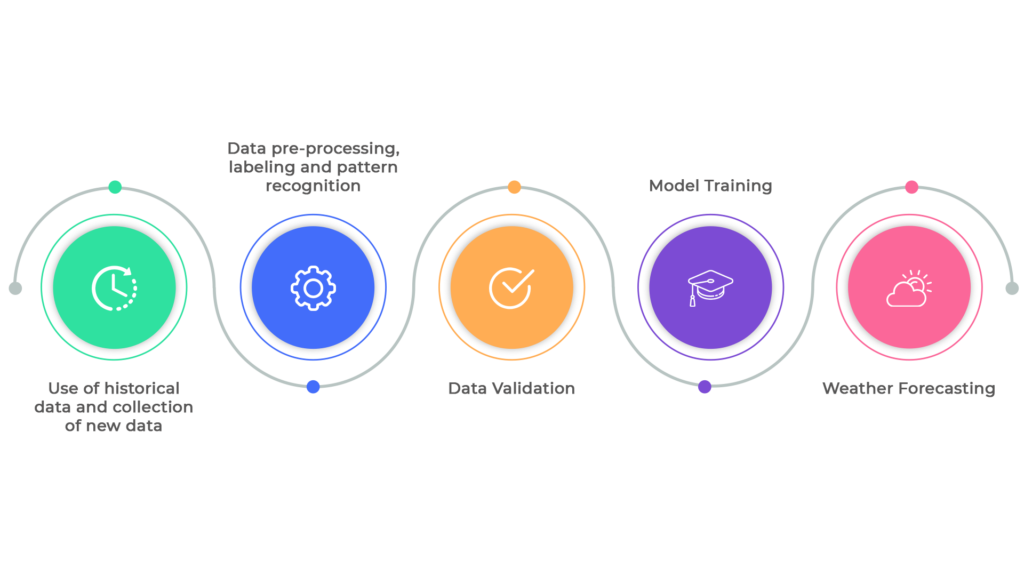

For most ordinary folks, weather forecasting is a small bit at the end of the news shows they view regularly. Most don’t even pay attention to it unless there is a serious announcement of an impending storm or similar natural catastrophes. However, for governments around the world and some industries like agriculture, marine and aviation logistics, and trade, weather forecasting is an entity they watch closely every single day. Since it has such an impact on these industries, accurate weather forecasting using AI can really help them in multiple ways.
From predicting hazardous climatic conditions well in advance to suggesting the best time for crop harvests, and the safest route for flights and ships to avoid stormy weather, weather forecasting is a huge industry today. As in other business environments, technology has become the key enabler of success in the weather forecast industry. In fact, research predicts that by 2025 there will be nearly USD 4.63 billion worth of market globally for weather forecasting systems.
As weather prediction and forecasting systems began to scale, the amount of data that was created and managed within them also faced explosive growth. Ultimately, successful weather prediction became a mainstream focus area for technologies centered around big data and analytics. And the latest sensation in this trend and in fact the best so far is the use of Artificial Intelligence (AI) in weather forecasting.
Related article How to implement Artificial Intelligence in your business
Today, high-performance computing is more accessible from a cost perspective, thanks to the evolution of cloud computing. This boosts the potential of leveraging AI to predict weather conditions more accurately and consistently. Truckloads of data can be analyzed using a diverse range of models powered by several algorithms in a matter of seconds to uncover granular details about weather patterns.
Let us explore the major possibilities and limitations of weather forecasting using AI today:
One of the earliest warning signals of storm surges is large fluctuations in temperature and humidity conditions over ocean surfaces. There are sensors deployed over the ocean surface that collate data on water temperature, variations in tide patterns, unusual heat or vibratory signals and pass it on to onshore data hubs. Similarly, satellites circling our atmosphere constantly pick up data on atmospheric conditions concerning temperature, pressure cycles, and much more.
In the past, this data had to be first combined to form a weather system framework. The data would then have to be manually compared to historic weather frameworks to notice any alarming similarities to storm patterns. This usually took time and intense manual effort. By leveraging AI, classifying storm behavioral patterns based on analyzing historic and live real-time data can be done in a matter of seconds rather than the days it took in the past.
Related article on AI powered Cloud Occerance Prediction
Weather systems formed naturally in our atmosphere are constantly in motion. For example, a low-pressure depression occurring above an oceanic region has the potential to migrate to any direction from its origin and further deviate into sub-streams in the direction it moved since inception. This is why every country has its own network of weather systems comprised of satellites and other shore and sea-based sensors. By leveraging AI, it is possible for synchronizing the data captured and analyzed by different countries into a global framework and autonomously track the movement of weather systems more precisely. This can be a huge advantage for marine and aviation sectors as route planners in either of these domains can use the prediction information to chart safer routes that avoid any weather hazards.
While daily or yearly weather and seasonal climate behavior prediction is quite common today, the biggest focus for world leaders is to have a tab on global warming and other climatic events of a similar scale. For such a massive scale of prediction to be possible, historic climate data from as back as humanly recorded must be analyzed to see patterns of change.

Adding further complexity to this process is the diversity of data points captured across different countries, the demographic, social, industrial, and economic characteristics exhibited by them over time, and several other granular details. Building data models around such a vast and diverse set of historic data are nearly impossible if not for AI systems having high computing power. AI makes the data correlation and climatic mapping process highly efficient with no scope for biased decisions. It can quickly learn about unique events that occurred in the past for weather systems in the world and use it to predict when it may repeat again.
Predicting weather conditions is a crucial part of AI’s impact in the weather sector. However, an even bigger impact can be made when AI systems can predict the exact spot where a climatic event will occur. A real-life example has been demonstrated by Swiss researchers who coupled standard meteorological readings with machine learning to accurately predict lightning strikes within an 18.6-mile zone with a timing accuracy ranging from 10 to 30 minutes. As AI systems scale up with more relevant data, such advancements can be life-saving moments in areas where high mortality rates are owing to lightning strikes.
As with any sector, AI in weather forecasting is not a fully developed ecosystem. It is continuously evolving as more countries and private organizations invest in building better data governance and information exchange systems globally for seamless weather prediction capabilities. There are limitations for present AI models such as limited data availability for certain weather conditions, gated information highways set up by certain countries, differences in technology and hardware standards used by weather systems across different countries, and so on.
However, over time, AI will be a key pillar in enabling mankind to predict and handle nature’s fiercest avatars and create widespread socio-economic safety frameworks globally against weather uncertainties.
Talk to our experts today to find out.